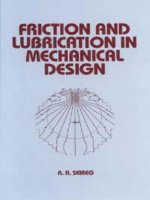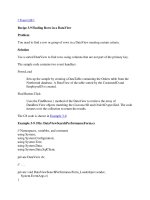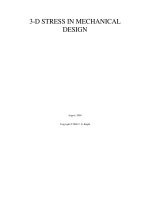Tài liệu 3-D STRESS IN MECHANICAL DESIGN doc
Bạn đang xem bản rút gọn của tài liệu. Xem và tải ngay bản đầy đủ của tài liệu tại đây (204.32 KB, 6 trang )
3-D STRESS IN MECHANICAL
DESIGN
August 2000
Copyright 2000 C. E. Knight
PURPOSE OF THE TUTORIAL
This tutorial is designed to introduce and place strong emphasis on the role of 3-D stress in the process of
mechanical design. Students in engineering are normally introduced to stress in its simplest one-
component form defined by load divided by area of cross section.. This is a valid definition of a pure 1-D
state of stress, but in many cases it seems to establish a baseline safe position for which many students
don’t want to venture forth. Carrying this attitude through the mechanical design process is a recipe for
failure.
Everything in the mechanical design realm has solid 3-D characteristics. The same is true for the state of
stress in the solid. In many simple cases the effective state of stress can be reduced to 2-D or 1-D, but only
after careful consideration. In the early stages of mechanical design, the locations of most likely stress
failure and the corresponding stress components acting at those locations must be identified. Once all the
stress components at a given location are determined, they may then be combined to find principal stresses,
maximum shear stress or other measures that are useful for predicting design success or failure. It is very
important to remember that stress components for one location in a machine part should never
be
combined with stress components for a different location in the same part.
One of the interesting developments in visualizing the combining of 2-D stress components was the
creation of Mohr’s circle. This graphical representation of the 2-D stress transformation equations provides
a quick, accurate and visual protrayal of the 2-D state of stress. It finds the principal stresses and a
maximum shear stress (although this maximum shear stress may be quite misleading in 3-D stress).
Review of Two-Dimensional Mohr’s Circle - Graphical Approach
The beginning of a Mohr’s circle representation must be a stress element sketch of the 2-D state of stress as
shown in the figure.
This shows all potential non-zero 2-D stress components. The graphical Mohr’s circle uses coordinate
pairs of these data to make a plot. They are (σ
x
, τ
xy
) and (σ
y
, τ
yx
). These two points establish the circle
diameter. By convention normal stresses, σ are positive in tension and negative in compression, however,
the shear stresses, τ, in the Mohr’s circle constructions are taken as positive if they make a cw moment
about the stress element. In the stress element above, τ
xy
is ccw (-) while τ
yx
is cw(+). This convention is
useful for determining the proper orientation of principal stresses and other components relative to the x,y
coordinates.
As an example, assume that σ
x
is positive and τ
xy
is positive (cw) with σ
y
equal zero. First sketch the
normal stress axis along the horizontal and the shear stress axis along the vertical. Then plot the first
coordinate pair (σ
x
, τ
xy
) at point A. Then plot the second pair (0, τ
yx
) at point B. These two points form
the diameter of the circle with its center at point C. Simple geometric triangles can then determine the
circle radius and all principal stress and peak shear stress values.
In a second example, assume that σ
x
is smaller than σ
y
, but both are positive, and that τ
xy
is cw. Sketch the
normal stress, σ, and shear stress, τ axes and plot the coordinate pair (σ
x
, τ
xy
) at point A and then (σ
y
, τ
yx
) at
point B. Connecting these points locates the circle center at point C. Geometrical calculations finish the
numerical values.
The Mohr’s circle gives a complete visual representation of the 2-D state of stress along with accurate
numerical values. However, there is a highly significant factor in mechanical design that has thus far been
neglected. That factor is the influence of the additional 3-D stress components on the design safety.
Three-Dimensional Stress in Mechanical Design
In the real world of applications all objects are 3-D. The general state of stress is pictured on the stress
element below. There are six independent stress components shown in a conventient Cartesian coordinate
system. It is readily seen that in the 2-D Mohr’s circle, the principal stresses are larger numerically than the
cartesion components unless they are already principal stresses. The same is true in 3-D stress. A qubic
equation can be solved for the three principal stress roots in the general stress case, however, in many
cases of mechanical design some of the principal stresses may be determined by inspection.
3-D Mohr’s Circles
Use of Mohr’s circles can again make visualization of the stress condition clearer to the designer. The
definition of the three circle diagram is sketched below. Note that the principal stress values are always
ordered by convention so the σ
1
is the largest value in the tensile direction and σ
3
is the largest value in the
compressive direction. Note also that there is one dominant peak shear stress in this diagram. Be
forewarned the principal stresses and this peak shear stress are going to play a strong role in
determining the factor of safety in mechanical design.
What about the two 2-D examples? How do they become 3-D representations? If the stress state is only
two-dimensional, then σ
z
and all the shear stresses with z components are zero, therefore, σ
z
= 0 is the third
principal stress. Only two principal stresses were found by the Mohr’s circle transformation. Since σ
z
= 0,
it must not be important. Wrong!! Look at the modified examples below. In example 1, the second
principal stress, σ
2
,
becomes zero and the third principal stress, σ
3
, is negative, but the overall range is the
same. In this case, there is no effect on the overall stress state.
However, the second example has the same first two principal stresses σ
1
and σ
2
, but σ
3
is 0. This enlarges
the outermost circle which means that the overall state of stress has increased. In this case, there is an
appreciable contribution by the 3-D effect that must not be ignored in accounting for design safety.
Example 3
As a final example, use the stress conditions σ
x
= 90 (T), τ
xy
= 40 ccw, σ
y
= 30 (T), and σ
z
= - 25 (C).
First sketch the normal stress and shear stress axes and then plot the coordinate pair ( σ
x
, τ
xy
) at A. Plot the
next coordinate pair ( σ
y
, τ
yx
) at B. Connect points A and B to form the diameter of the 2-D Mohr’s circle
with center at C. Draw the circle and determine two of the principal stresses. The center C is located at a
stress value of 60. The triangle C, σ
x
, and τ
xy
form a 30, 40, 50 triangle, so the circle radius is 50. The two
principal stresses from the 2-D circle are 110 (T) and 10(T). Since there are no non-zero z component
shear stresses, σ
z
is the third principal stress with a value of –25 (C). The maximum shear stress is at the
peak of the largest circle and is equal to half the difference between σ
1
and σ
3
.









